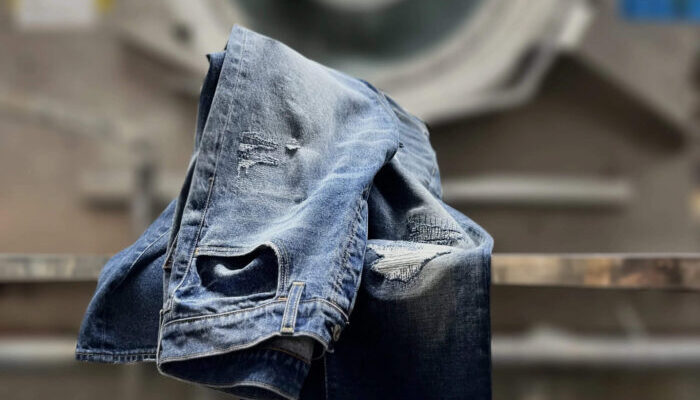Monday, June 21, 2021
Zaber and Zubair Fabrics Ltd, a supplier of home textiles to major European retailers H&M and Lidl, is one of a growing band of Bangladeshi garment factories on a mission to clean up their act – and improve their bottom lines by going greener.
The business on the outskirts of Dhaka previously used large amounts of sulphuric acid to remove excess caustic, a chemical that strengthens fabric, from its waste water.
But in 2010, the factory installed two plants that recover from the water 95% of the caustic used to rinse the fabrics made into goods like sheets and pillow covers, saving 6.5 million litres of caustic soda annually as well as sulphuric acid.
The plants also generate hot water as a by-product, which is used in machines to process fabrics at high temperatures, economising on water and electricity.
The plants cost about $2.3 million to set up but have helped the factory save $3.8 million a year through buying fewer chemicals, treating less waste water and lowering energy bills.
“Using green energy, or installing plants that recycle, saves cost in the long run,” said Zakir Hossen, sustainability head for the factory which employs 8,000 workers.
Climate activists say the global fashion industry should intensify efforts to cut climate-heating emissions in line with the Paris Agreement goals of limiting average temperature rise to “well below” 2 degrees Celsius above preindustrial times.
Zaber and Zubair Fabrics has rooftop solar panels that can generate about 400 kilowatts of power. While that is less than 1% of the factory’s needs, it plans to add more solar capacity in the coming years.
“To survive, we have to give customers good products at a low price. And if we don’t gradually shift to green energy, we won’t be able to do that… This also helps the environment,” Hossen told the Thomson Reuters Foundation.
The apparel industry produces 4% of the world’s planet-warming emissions, equal to the combined annual total of France, Germany and Britain, according to a 2020 study by the nonprofit Global Fashion Agenda and consultants McKinsey and Company.
The U.N. Environment Programme in 2019 put the fashion industry’s share of global carbon emissions at 10% – more than for all international flights and maritime shipping – and said it was the second-biggest consumer of water.
Bangladesh’s overall emissions are tiny compared with industrialised countries, but its garment sector is the world’s second-largest exporter of clothes and employs about 4 million people.
Brands Pay the Same
Last year, the Green Climate Fund, the main U.N.-backed climate finance channel for developing countries, approved a $250-million loan programme for projects to make garment factories in Bangladesh more energy efficient.
Buoyed by economic arguments and pressure from brands to reduce emissions along the fashion supply chain, an increasing number of Bangladeshi factories are taking steps to lower their energy usage, industry experts said.
The Partnership for Cleaner Textile (PaCT), a programme led by the International Finance Corporation (IFC) to assist Bangladeshi factories in adopting cleaner production practices, said it has helped 338 factories cut their greenhouse gas emissions by more than half a million tonnes a year.
“That’s equal to removing over 119,000 cars from the road,” said Nishat Chowdhury, programme manager for PaCT, which was launched in 2013 and is supported by Denmark, Australia and the Netherlands, as well as major clothing brands.
“More and more factories are nominating themselves for the programme, because they know they must go green to remain competitive in the international market. However, uptake is slow due to policy barriers… This market needs to grow,” she added.
PaCT’s recommendations include installing heat recovery boilers to utilise exhaust gas heat from generators, cutting power usage through energy-efficient appliances, and recycling water after condensation.
These steps have helped factories each save thousands of dollars annually, curb emissions and save water, five owners told the Thomson Reuters Foundation.
Bangladesh also has more than 140 factories certified by LEED, a U.S.-based rating system for green buildings. Constructing such factories requires at least 15-20% more capital investment, the owners said.
“You need to spend on expensive things,” said Asif Ashraf from Urmi Group, which owns a LEED-approved factory. “For instance, you need a special toilet that doesn’t use more than a specific amount of water – you also need a special A.C.”
Despite their extra investment, factory owners said they had failed to secure better prices from international brands. Buyers need to pay more if they want their supply chains to be climate-neutral or climate-positive in the future, manufacturers said.
“If (brands) want to achieve this goal, they will need to give a favourable price… They need to motivate factories,” said Faruque Hassan, president of the Bangladesh Garment Manufacturers and Exporters Association, which has about 4,000 members.
Mohammad Tamim, dean of the School of Engineering at the Bangladesh University of Engineering and Technology, said he did not think it would be possible for most factories to go fully “climate positive” or depend solely on renewable energy.
“Factories can further minimise emissions and maybe go to net zero at some point. But with the limited space (they) have, renewable energy can at best serve just 5% of their power needs (now),” he added.
For more information, visit https://www.reuters.com/article/bangladesh-textiles-climate-workers/feature-business-savvy-bangladesh-fabric-factories-take-on-a-greener-hue-idUSL5N2NS1D9?edition-redirect=in
Featured News

PaCT program manager attends Bharat Tex as panelist
March 6, 2024
Number of LEED certified factories in RMG reaches 202
September 17, 2023

Spearheading sustainable industries
August 6, 2023
IFC organizes Africa-Asia Roadshow in Bangladesh
June 19, 2023

